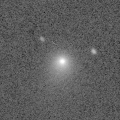
|
Now it is 9.1 mag (June 25, Juan Jose Gonzalez). It is expected to keep so bright as 6-8 mag for a long time from 2011 to 2012, and to be observable in good condition in the Northern Hemisphere. In the Southern Hemisphere, it keeps observable in good condition until October when it brightens up to 6.5 mag.
Date(TT) R.A. (2000) Decl. Delta r Elong. m1 Best Time(A, h)
June 25 22 50.09 1 2.9 2.317 2.810 108 9.3 3:00 (320, 49)
July 2 22 42.70 2 52.5 2.141 2.742 115 9.0 3:03 (332, 55)
|

|
It will be 12-13 mag in June and July. However, it is not observable at all due to the bad condition in this apparition.
Date(TT) R.A. (2000) Decl. Delta r Elong. m1 Best Time(A, h)
June 25 7 12.06 24 55.8 2.352 1.385 13 12.6 21:04 (128, -8)
July 2 7 37.93 24 32.2 2.356 1.384 12 12.6 21:04 (128, -8)
|

|
It has returned after 27-year blank since 1984. Now it is 15.0 mag (June 24, Hidetaka Sato). It will approach to the sun down to 0.75 A.U. and brighten up to 10.5 mag in July and August. However, the condition of this apparition is bad. It locates extremely low, and only observable until mid July in the Northern Hemisphere. It locates extremely low and hard to observe in the Southern Hemisphere.
Date(TT) R.A. (2000) Decl. Delta r Elong. m1 Best Time(A, h)
June 25 3 36.30 33 29.1 1.688 1.046 35 13.5 3:00 (239, 14)
July 2 4 17.70 32 51.3 1.640 0.965 33 12.8 3:03 (238, 12)
|

|
It will approach to the sun down to 0.5 A.U. in September, and it is expected to brighten up to 6 mag. Now it is 12.1 mag, brightening rapidly (June 23, Chris Wyatt). In the Southern Hemisphere, it keeps observable until early September when it becomes 7 mag. In the Northern Hemisphere, it becomes unobservable in August. But after appearing in the morning sky in October, it becomes observable in the excellent condition at midnight.
Date(TT) R.A. (2000) Decl. Delta r Elong. m1 Best Time(A, h)
June 25 10 38.22 7 13.7 1.795 1.655 65 13.5 21:04 ( 84, 21)
July 2 10 44.39 6 37.9 1.766 1.542 60 13.1 21:04 ( 87, 16)
|
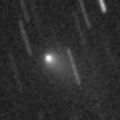
|
Now it is 13.2 mag and visible visually (June 21, Jakub Koukal). It will brighten up to 11-12 mag in autumn. In the Northern Hemisphere, it keeps observable for a long time until 2012 spring, although it becomes low temporarily in July. In the Southern Hemisphere, it is not observable until November.
Date(TT) R.A. (2000) Decl. Delta r Elong. m1 Best Time(A, h)
June 25 7 21.68 71 56.9 2.664 2.147 49 13.2 21:04 (162, 25)
July 2 7 29.07 69 35.3 2.675 2.117 47 13.2 21:04 (162, 22)
|

|
First return of a new periodic comet which brightened up to 13 mag in a major outburst in 2005. Now it is very bright as 11.9 mag and visible visually (June 26, Chris Wyatt). It will be observable in an excellent condition from summer to winter.
Date(TT) R.A. (2000) Decl. Delta r Elong. m1 Best Time(A, h)
June 25 23 7.89 -3 53.8 1.599 2.124 106 13.3 3:00 (319, 42)
July 2 23 13.02 -2 35.2 1.532 2.126 111 13.3 3:03 (325, 47)
|

|
Now it is bright and visible visually at 13.1 mag (June 6, Chris Wyatt). It keeps bright as 13-14 mag for a long time after this until 2013. It is not observable in the Northern Hemisphere, but it is observable in good condition in the Southern Hemisphere.
Date(TT) R.A. (2000) Decl. Delta r Elong. m1 Best Time(A, h)
June 25 10 59.21 -78 34.3 5.211 5.631 109 13.5 21:04 ( 12,-30)
July 2 10 54.22 -77 41.3 5.234 5.618 107 13.5 21:04 ( 14,-31)
|

|
New comet. Very bright as 14.4 mag (June 24, Hidetaka Sato). It will brighten up to 11.5 mag in summer and autumn. In the Northern Hemisphere, it keeps observable until winter, although it becomes very low from mid August to late September. In the Southern Hemisphere, it is not observable until November.
Date(TT) R.A. (2000) Decl. Delta r Elong. m1 Best Time(A, h)
June 25 0 33.75 42 46.4 1.563 1.557 70 13.9 3:00 (243, 50)
July 2 0 55.73 49 49.5 1.455 1.469 70 13.5 3:03 (232, 52)
|

|
New comet. Bright as 13.2 mag (June 12, Artyom Novichonok). It will be observable at 13 mag in good condition in summer. In the Northern Hemisphere, it keeps observable at 14-15 mag in good condition until autumn. In the Southern Hemisphere, it will become low after August.
Date(TT) R.A. (2000) Decl. Delta r Elong. m1 Best Time(A, h)
June 25 22 16.10 -4 0.9 1.315 2.008 118 14.1 3:00 (335, 48)
July 2 21 59.95 0 59.7 1.207 1.985 126 13.9 3:03 (351, 56)
|

|
Now it is 13.4 mag and visible visually (June 24, Jakub Koukal). It will be observable at 13-14 mag for a long time from 2011 to 2012.
Date(TT) R.A. (2000) Decl. Delta r Elong. m1 Best Time(A, h)
June 25 19 37.69 -5 14.2 4.675 5.598 152 14.0 1:28 ( 0, 50)
July 2 19 28.82 -5 30.7 4.615 5.577 159 13.9 0:52 ( 0, 50)
|

|
Now it is bright as 12.5 mag and visible visually (June 23, Chris Wyatt). It is getting lower in the evening sky. It will be unobservable in early July in the Northern Hemisphere, or in mid August in the Southern Hemisphere.
Date(TT) R.A. (2000) Decl. Delta r Elong. m1 Best Time(A, h)
June 25 10 51.50 0 57.7 6.515 6.258 70 14.0 21:04 ( 77, 20)
July 2 10 54.48 0 41.8 6.617 6.258 65 14.1 21:04 ( 80, 15)
|

|
Big asteroid discovered in 1906. It suddenly showed the cometary activity on Dec. 11, probably due to an impact of a small object. It was very bright as 11.5 mag visually (Dec. 17, Juan Jose Gonzalez). It had a dust coma still on Jan. 9 (Joseph Brimacombe). Now it is stellar at 13.8 mag (Apr. 5, Juan Jose Gonzalez). It is getting lower in the evening sky, and will be unobservable in August.
Date(TT) R.A. (2000) Decl. Delta r Elong. m1 Best Time(A, h)
June 25 10 11.32 24 33.8 3.266 2.793 54 14.6 21:04 (104, 24)
July 2 10 20.84 23 23.6 3.324 2.781 49 14.6 21:04 (105, 20)
|

|
It approached to the sun down to 0.88 A.U. in mid April, and it brightened up to 8.6 mag (Apr. 13, Juan Jose Gonzalez). Now it is fading. It has already faded down to 14.8 mag by CCD observations (June 20, Hidetaka Sato). However, it is still very bright visually as 11.3 mag (June 28, Jakub Koukal). It will get diffuse and fade out rapidly after this.
Date(TT) R.A. (2000) Decl. Delta r Elong. m1 Best Time(A, h)
June 25 1 56.89 16 30.4 1.683 1.469 60 14.8 3:00 (266, 24)
July 2 2 9.14 16 41.3 1.710 1.559 63 15.5 3:03 (269, 28)
|

|
It has brightened in outburst up to 14 mag in 2006 January. Another outburst occured in late May. Now it is bright as 14.3 mag (June 4, Juan Jose Gonzalez).
Date(TT) R.A. (2000) Decl. Delta r Elong. m1 Best Time(A, h)
June 25 16 8.07 -16 13.1 7.558 8.453 149 14.9 21:55 ( 0, 39)
July 2 16 6.23 -16 9.8 7.602 8.434 142 15.0 21:25 ( 0, 39)
|
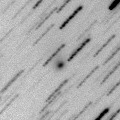
|
Now it is fading slowly, but still bright as 14.0 mag (June 15, Hidetaka Sato). It will keep 14-15 mag until mid September.
Date(TT) R.A. (2000) Decl. Delta r Elong. m1 Best Time(A, h)
June 25 23 57.99 7 26.5 2.779 2.967 90 15.0 3:00 (295, 43)
July 2 23 56.55 5 37.7 2.688 3.005 98 15.0 3:03 (305, 47)
|
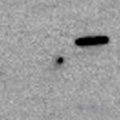
|
Now it is 15.2 mag (June 24, Hidetaka Sato). It brightens up to 12 mag in autumn. But the condition is bad. In the Northern Hemisphere, the altitude will be lower than 20 degree in June when it brightens up to 15 mag, then it will be unobservable in August. After the perihelion passage, it is only observable from December to February in the evening very low sky. In the Southern Hemisphere, it keeps observable for a long time, although it keeps locating extremely low. The component B was not detected, fainter than 20 mag (May 14, Hidetaka Sato).
Date(TT) R.A. (2000) Decl. Delta r Elong. m1 Best Time(A, h)
June 25 9 57.11 21 58.2 2.213 1.768 51 15.5 21:04 (103, 20)
July 2 10 9.72 20 26.8 2.204 1.702 48 15.2 21:04 (103, 17)
|

|
Now it is 15.3 mag (June 26, Jakub Cerny). It keeps 15 mag from 2011 summer to 2012 summer. But it is not observable around the perihelion. It is observable in good condition in the Northern Hemisphere in 2011, and in the Southern Hemisphere in 2012.
Date(TT) R.A. (2000) Decl. Delta r Elong. m1 Best Time(A, h)
June 25 13 12.85 23 9.3 2.784 3.022 93 15.5 21:04 ( 74, 60)
July 2 13 16.37 21 56.5 2.816 2.976 88 15.5 21:04 ( 78, 55)
|

|
Already bright as 15.6 mag (June 26, Tzec Maun Observatory). It will be observable in good condition at 12 mag in autumn and winter.
Date(TT) R.A. (2000) Decl. Delta r Elong. m1 Best Time(A, h)
June 25 23 34.39 3 54.5 2.221 2.556 97 15.9 3:00 (305, 44)
July 2 23 40.68 4 43.2 2.108 2.526 102 15.6 3:03 (311, 49)
|

|
Now it is 15.4 mag (May 14, Ken-ichi Kadota). It will be fading gradually, and will be fainter than 18 mag in September.
Date(TT) R.A. (2000) Decl. Delta r Elong. m1 Best Time(A, h)
June 25 0 16.09 -11 39.2 1.824 2.148 93 15.6 3:00 (308, 26)
July 2 0 22.01 -11 39.1 1.785 2.189 99 15.8 3:03 (313, 30)
|

|
Now it is 15.8 mag (June 24, J. F. Hernandez). It will brighten rapidly, and will be observable at 15 mag in good condition from July to October. It locates somewhat low in the Northern Hemisphere.
Date(TT) R.A. (2000) Decl. Delta r Elong. m1 Best Time(A, h)
June 25 20 43.33 -16 58.8 1.493 2.393 144 15.8 2:33 ( 0, 38)
July 2 20 42.20 -17 52.9 1.438 2.381 151 15.6 2:05 ( 0, 37)
|

|
It is expected to keep 14-15 mag for a long time from 2011 summer to 2012 summer. The condition is good in the Southern Hemisphere, and it keeps observable for a long time. In the Northern Hemisphere, it is observable in the low sky in 2011 spring. But after that, it is not observable until 2012 August. However, this comet was observed only during two days in 2010 June. So the orbital elements are extremely uncertain.
Date(TT) R.A. (2000) Decl. Delta r Elong. m1 Best Time(A, h)
June 25 17 18.54 -45 40.1 2.434 3.384 155 15.7 23:04 ( 0, 9)
July 2 17 3.48 -47 3.6 2.419 3.332 148 15.6 22:22 ( 0, 8)
|

|
Brightening rapidly. Now it is 15.4 mag (June 25, Tzec Maun Observatory, Mayhill). It was observed as bright as 14.2 mag visually (June 26, Jakub Cerny). It is expected to be 13 mag and will be observable in good condition in 2013. In the Northern Hemisphere, it keeps observable for a long time after this. It is not observable in the Southern Hemisphere.
Date(TT) R.A. (2000) Decl. Delta r Elong. m1 Best Time(A, h)
June 25 2 6.85 58 32.7 8.140 7.610 55 15.8 3:00 (219, 37)
July 2 2 6.97 59 14.5 8.046 7.581 59 15.7 3:03 (219, 41)
|
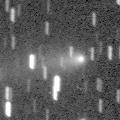
|
It reached up to 14.0 mag and became visible visually in December (Dec. 17, Juan Jose Gonzalez). Then it has been fading, and faded down to 18.3 mag on Mar. 31 (Yasukazu Ikari). However, it brightened up to 16 mag in outburst on Apr. 5. Then it kept brightening and reached up to 14.7 mag (May 28, Hidetaka Sato). It is still bright as 15.1 mag (June 22, Hidetaka Sato). It locates too low to observe in the Southern Hemisphere. It will be unobservable soon in the Northern Hemisphere.
Date(TT) R.A. (2000) Decl. Delta r Elong. m1 Best Time(A, h)
June 25 9 23.73 34 19.0 3.539 2.877 42 15.8 21:04 (118, 20)
July 2 9 35.94 33 19.6 3.621 2.908 39 16.0 21:04 (119, 17)
|
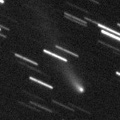
|
It reached up to 14 mag in 2010 autumn and winter. Now it is fading. In the Southern Hemisphere, it keeps observable in good condition while fading gradually. In the Northern Hemisphere, it will never be observable again.
Date(TT) R.A. (2000) Decl. Delta r Elong. m1 Best Time(A, h)
June 25 5 32.13 -27 41.8 3.770 3.245 52 15.9 3:00 (277,-43)
July 2 5 38.36 -29 19.1 3.757 3.275 54 15.9 3:03 (282,-39)
|

|
Now it is 15.9 mag (June 27, P. Dupouy). It will be fading very slowly after this. In the Northern Hemisphere, it keeps observable for a long time until 2012 spring when it fades down to 17-18 mag. It will not be observable in the Southern Hemisphere.
Date(TT) R.A. (2000) Decl. Delta r Elong. m1 Best Time(A, h)
June 25 22 55.25 50 36.8 5.013 5.001 83 16.0 3:00 (222, 65)
July 2 22 56.74 51 17.1 4.973 5.025 87 16.0 3:03 (214, 69)
|

|
Now it is 15.0 mag (June 26, Tzec Maun Observatory). Brighter than originally predicted. It will be observable at 15-16 mag in good condition from summer to autumn.
Date(TT) R.A. (2000) Decl. Delta r Elong. m1 Best Time(A, h)
June 25 23 0.35 -14 9.3 1.494 2.098 111 16.2 3:00 (327, 34)
July 2 23 7.21 -14 10.9 1.431 2.099 117 16.1 3:03 (334, 37)
|

|
Now it is 15.8 mag (June 2, J. F. Soulier and A. Novichonok). It will brighten up to 16 mag from summer to autumn, and will be observable in good condition.
Date(TT) R.A. (2000) Decl. Delta r Elong. m1 Best Time(A, h)
June 25 16 12.08 -1 13.8 1.322 2.222 143 16.3 21:59 ( 0, 54)
July 2 16 10.00 -1 28.5 1.341 2.199 137 16.3 21:29 ( 0, 53)
|

|
It reached up to 7.7 mag in 2009 summer (2009 Aug. 13, Chris Wyatt). Now it is fading. It has already faded down to 15.5 mag (May 31, Hidetaka Sato). It will never be observable again in the Northern Hemisphere. In the Southern Hemisphere, it keeps observable in good condition until 2011 autumn when it becomes fainter than 18 mag.
Date(TT) R.A. (2000) Decl. Delta r Elong. m1 Best Time(A, h)
June 25 16 11.97 -65 1.8 6.280 7.024 134 16.3 21:58 ( 0,-10)
July 2 16 0.59 -64 37.3 6.365 7.072 130 16.4 21:20 ( 0,-10)
|

|
It became bright as 12 mag in 2010. Now it is fading. Appearing in the morning sky.
Date(TT) R.A. (2000) Decl. Delta r Elong. m1 Best Time(A, h)
June 25 1 53.28 3 5.1 3.839 3.546 65 16.3 3:00 (279, 18)
July 2 1 58.91 3 29.7 3.766 3.566 70 16.3 3:03 (282, 23)
|

|
It is expected to be bright as 9 mag from 2012 to 2013. Now it is 16.7 mag (June 19, Toshiyuki Takahashi). In the Northern Hemisphere, it keeps observable in good condition for a long time until 2012 autumn when the comet brightens up to 10 mag. In the Southern Hemisphere, it is hardly observble before the perihelion passage. But it becomes observable in good condition since 2013 after the perihelion passage.
Date(TT) R.A. (2000) Decl. Delta r Elong. m1 Best Time(A, h)
June 25 11 36.61 59 52.1 6.544 6.190 65 16.5 21:04 (143, 47)
July 2 11 40.07 58 54.3 6.536 6.133 62 16.5 21:04 (141, 44)
|

|
Now it is 17.1 mag (June 24, J. F. Hernandez). It will brighten up to 13 mag in next winter. But the condition of this apparition is bad, and it will not be observable around the perihelion passage. It will be observable until July when it brightens up to 16 mag in the Northern Hemisphere, or until September when it brightens up to 15 mag in the Southern Hemisphere.
Date(TT) R.A. (2000) Decl. Delta r Elong. m1 Best Time(A, h)
June 25 10 59.04 14 11.9 2.390 2.214 67 16.6 21:04 ( 87, 29)
July 2 11 8.17 12 47.9 2.426 2.175 63 16.5 21:04 ( 89, 24)
|

|
Now it is 16.9 mag (June 17, K. Hills). It was observed around 16 mag in 2009 and 2010. In 2011, it keeps observable at 17 mag from spring to autumn. It locates somewhat low in the Northern Hemisphere.
Date(TT) R.A. (2000) Decl. Delta r Elong. m1 Best Time(A, h)
June 25 17 7.11 -23 34.0 3.170 4.160 164 16.9 22:54 ( 0, 31)
July 2 17 2.88 -23 35.3 3.212 4.169 157 16.9 22:22 ( 0, 31)
|

|
New comet. Now it is 17.6 mag (June 6, R. H. McNaught). In the Southern Hemisphere, it keeps observable at 16-17 mag for a long time from summer to winter. It is not observable in the Northern Hemisphere.
Date(TT) R.A. (2000) Decl. Delta r Elong. m1 Best Time(A, h)
June 25 22 43.38 -39 25.8 1.804 2.491 121 17.2 3:00 (342, 13)
July 2 22 42.92 -44 52.9 1.691 2.441 126 17.0 3:03 (349, 9)
|
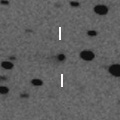
|
Now it is 17.3 mag (June 26, Hidetaka Sato). It keeps observable at 17 mag for a long time from 2011 to 2012.
Date(TT) R.A. (2000) Decl. Delta r Elong. m1 Best Time(A, h)
June 25 1 5.13 18 43.2 8.290 8.019 71 17.1 3:00 (271, 36)
July 2 1 4.02 18 53.2 8.172 8.019 77 17.1 3:03 (276, 43)
|

|
New comet. Now it is 16.6 mag (June 24, Hidetaka Sato). Good condition in the Southern Hemisphere. It will be getting higher also in the Northern Hemisphere. But it will fade out rapidly. It will be fainter than 18 mag in late July.
Date(TT) R.A. (2000) Decl. Delta r Elong. m1 Best Time(A, h)
June 25 15 45.16 -25 9.4 2.021 2.922 146 17.2 21:32 ( 0, 30)
July 2 15 41.28 -22 40.8 2.125 2.964 138 17.4 21:04 ( 1, 32)
|

|
Now it is 16.9 mag (May 4, Hidetaka Sato). It is observable at 17 mag for a long time from 2011 to 2013. In 2011, it is observable in good condition in summer.
Date(TT) R.A. (2000) Decl. Delta r Elong. m1 Best Time(A, h)
June 25 17 24.71 3 56.7 5.199 6.102 150 17.4 23:11 ( 0, 59)
July 2 17 16.74 3 57.7 5.215 6.083 145 17.4 22:35 ( 0, 59)
|

|
Appearing in the morning sky. It will brighten rapidly, and will be obserbale at 14 mag in good condition in autumn. It locates somewhat low in the Southern Hemisphere.
Date(TT) R.A. (2000) Decl. Delta r Elong. m1 Best Time(A, h)
June 25 3 11.52 2 29.5 2.397 1.886 48 17.6 3:00 (268, 1)
July 2 3 29.31 3 26.1 2.312 1.841 50 17.4 3:03 (269, 5)
|

|
Now it is 17.4 mag (June 24, J. F. Hernandez). It will brighten up to 15 mag in autumn and winter. But the condition of this apparition is bad. It is not observable around the perihelion passage. It will be getting lower in the evening sky after this. In the Southern Hemisphere, it will be observable until September when it brightens up to 16 mag. In the Northern Hemisphere, it is observable only until July.
Date(TT) R.A. (2000) Decl. Delta r Elong. m1 Best Time(A, h)
June 25 11 31.73 -6 32.4 2.115 2.236 83 17.6 21:04 ( 64, 23)
July 2 11 39.48 -7 9.3 2.156 2.195 78 17.5 21:04 ( 66, 19)
|

|
Now it is 16.6 mag (June 21, Hidetaka Sato). In the Northern Hemisphere, it keeps observable at 17 mag in good condition until summer. It locates low in the Southern Hemisphere.
Date(TT) R.A. (2000) Decl. Delta r Elong. m1 Best Time(A, h)
June 25 15 13.23 41 32.6 3.920 4.263 102 17.6 21:04 (171, 83)
July 2 15 1.65 40 43.9 4.021 4.287 98 17.7 21:04 (126, 80)
|

|
Peculiar asteroid moving along a comet-like retrograde orbit. Now it is 17.7 mag (June 22, Siding Spring Survey). It will be at opposition and observable at 17.5 mag in June and July. It has already passed the perihelion in January.
Date(TT) R.A. (2000) Decl. Delta r Elong. m1 Best Time(A, h)
June 25 20 8.22 -14 39.9 1.655 2.594 151 17.8 1:59 ( 0, 40)
July 2 19 40.87 -14 19.9 1.665 2.656 163 17.7 1:05 ( 0, 41)
|
|
![]()
 27P/Crommelin
27P/Crommelin C/2010 X1 ( Elenin )
C/2010 X1 ( Elenin ) C/2010 G2 ( Hill )
C/2010 G2 ( Hill ) 213P/2009 B3 ( Van Ness )
213P/2009 B3 ( Van Ness ) C/2009 F4 ( McNaught )
C/2009 F4 ( McNaught ) C/2011 M1 ( LINEAR )
C/2011 M1 ( LINEAR ) C/2011 L3 ( McNaught )
C/2011 L3 ( McNaught ) C/2006 S3 ( LONEOS )
C/2006 S3 ( LONEOS ) 29P/Schwassmann-Wachmann 1
29P/Schwassmann-Wachmann 1 (596) Scheila
(596) Scheila C/2011 C1 ( McNaught )
C/2011 C1 ( McNaught ) 174P/(60558) 2000 EC98 ( Echeclus )
174P/(60558) 2000 EC98 ( Echeclus ) C/2009 Y1 ( Catalina )
C/2009 Y1 ( Catalina ) 73P/Schwassmann-Wachmann 3
73P/Schwassmann-Wachmann 3 C/2011 A3 ( Gibbs )
C/2011 A3 ( Gibbs ) 78P/Gehrels 2
78P/Gehrels 2 9P/Tempel 1
9P/Tempel 1 48P/Johnson
48P/Johnson C/2010 M1 ( Gibbs )
C/2010 M1 ( Gibbs ) C/2010 S1 ( LINEAR )
C/2010 S1 ( LINEAR ) 240P/2010 P1 ( NEAT )
240P/2010 P1 ( NEAT ) C/2010 B1 ( Cardinal )
C/2010 B1 ( Cardinal ) C/2008 FK75 ( Lemmon-Siding Spring )
C/2008 FK75 ( Lemmon-Siding Spring ) 130P/McNaught-Hughes
130P/McNaught-Hughes 115P/Maury
115P/Maury C/2006 W3 ( Christensen )
C/2006 W3 ( Christensen ) 65P/Gunn
65P/Gunn C/2011 F1 ( LINEAR )
C/2011 F1 ( LINEAR ) 71P/Clark
71P/Clark 74P/Smirnova-Chernykh
74P/Smirnova-Chernykh C/2011 L2 ( McNaught )
C/2011 L2 ( McNaught ) C/2008 S3 ( Boattini )
C/2008 S3 ( Boattini ) C/2011 L1 ( McNaught )
C/2011 L1 ( McNaught ) C/2010 R1 ( LINEAR )
C/2010 R1 ( LINEAR ) 49P/Arend-Rigaux
49P/Arend-Rigaux 37P/Forbes
37P/Forbes C/2009 UG89 ( Lemmon )
C/2009 UG89 ( Lemmon ) 2009 YS6
2009 YS6![]()


























